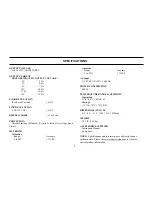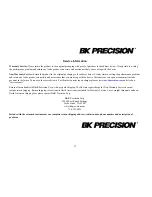
10
OPERATING INSTRUCTIONS
3.
The clip type TIE POINT terminals can be used to attach
equipment requiring
a maximum of 2 amps. Be sure to
observe polarity when connecting equipment.
4.
If more precision voltage readings are desired, connect a
high-accuracy multimeter, such as the 0.5%
B+K
Precision
Model 388A Digital Multimeter or equivalent
across a pair of (+) and (–) TIE POINT terminals.
NOTE
Use solid copper hook-up wire with a
minimum diameter of 12 AWG. Using
smaller wire may result in overheating of
the hook-up leads, and increases the
source resistance “seen” by the load,
thereby derating the maximum current
and regulation capabilities of the power
supply. Tighten connections snugly to
assure low resistance.
2.
Connect the red (+) OUTPUT terminal of the power supply to the
positive polarity input of the equipment being powered.
3.
Connect the black (–) OUTPUT terminal of the power supply to
the negative polarity input of the equipment being powered.
4.
Set the VOLTAGE control to its minimum (counter clockwise)
position.
5.
Turn on the power supply.
6.
Turn on the equipment being powered.
7.
Adjust the VOLTAGE control to the desired voltage as read on
the V meter.
CONSIDERATIONS
1.
Although vehicular electrical systems are typically referred to as
“12 volt systems”, the actual nominal operating voltage of such
systems is approximately 13.8 volts. Therefore, for purposes of
normal operation, adjust the power supply for 13.8 volts.
2.
Maximum current is dependent upon output voltage as shown in
Fig. 3.
Figure 3. Typical Output Voltage and
Output Current Characteristics






































